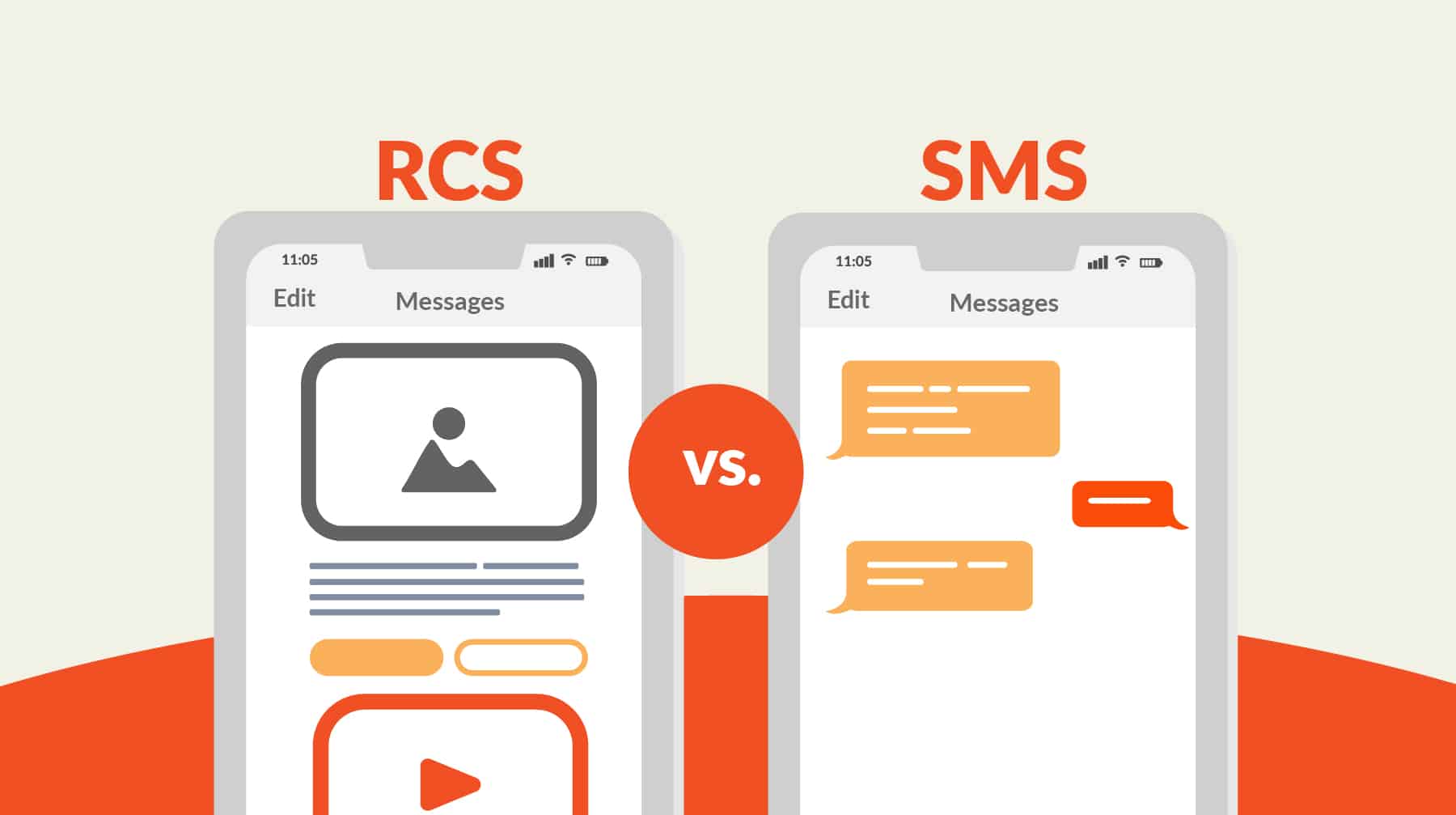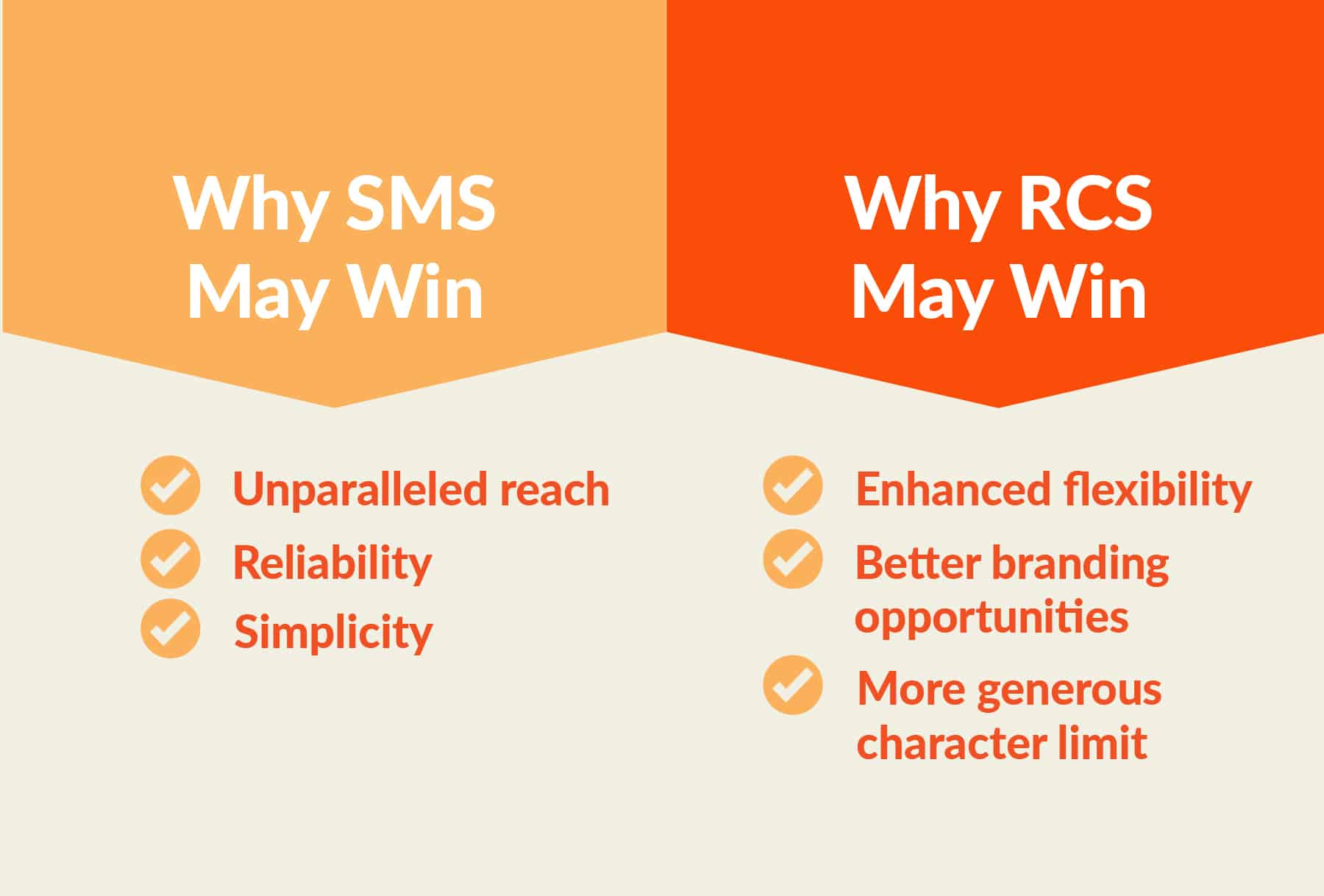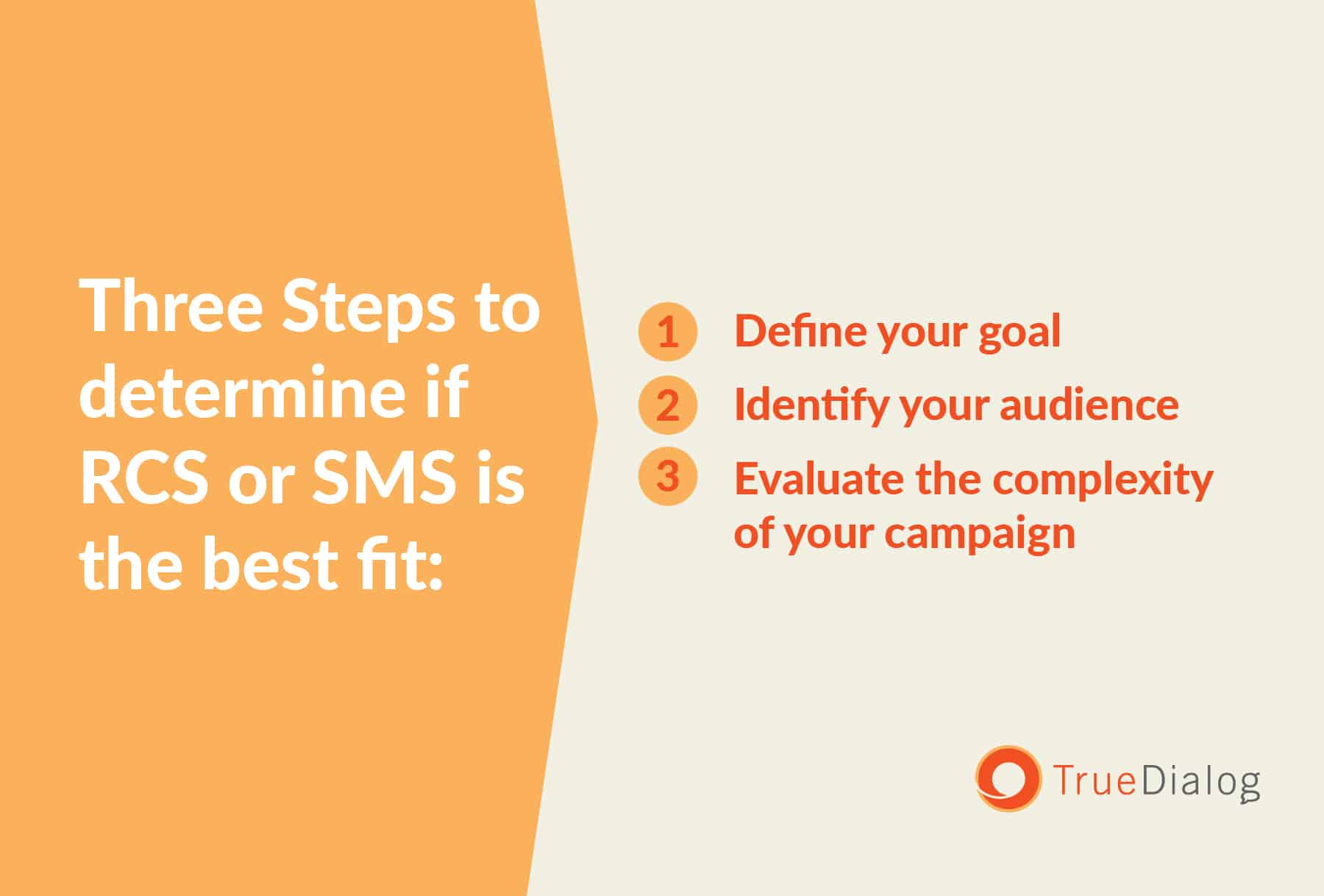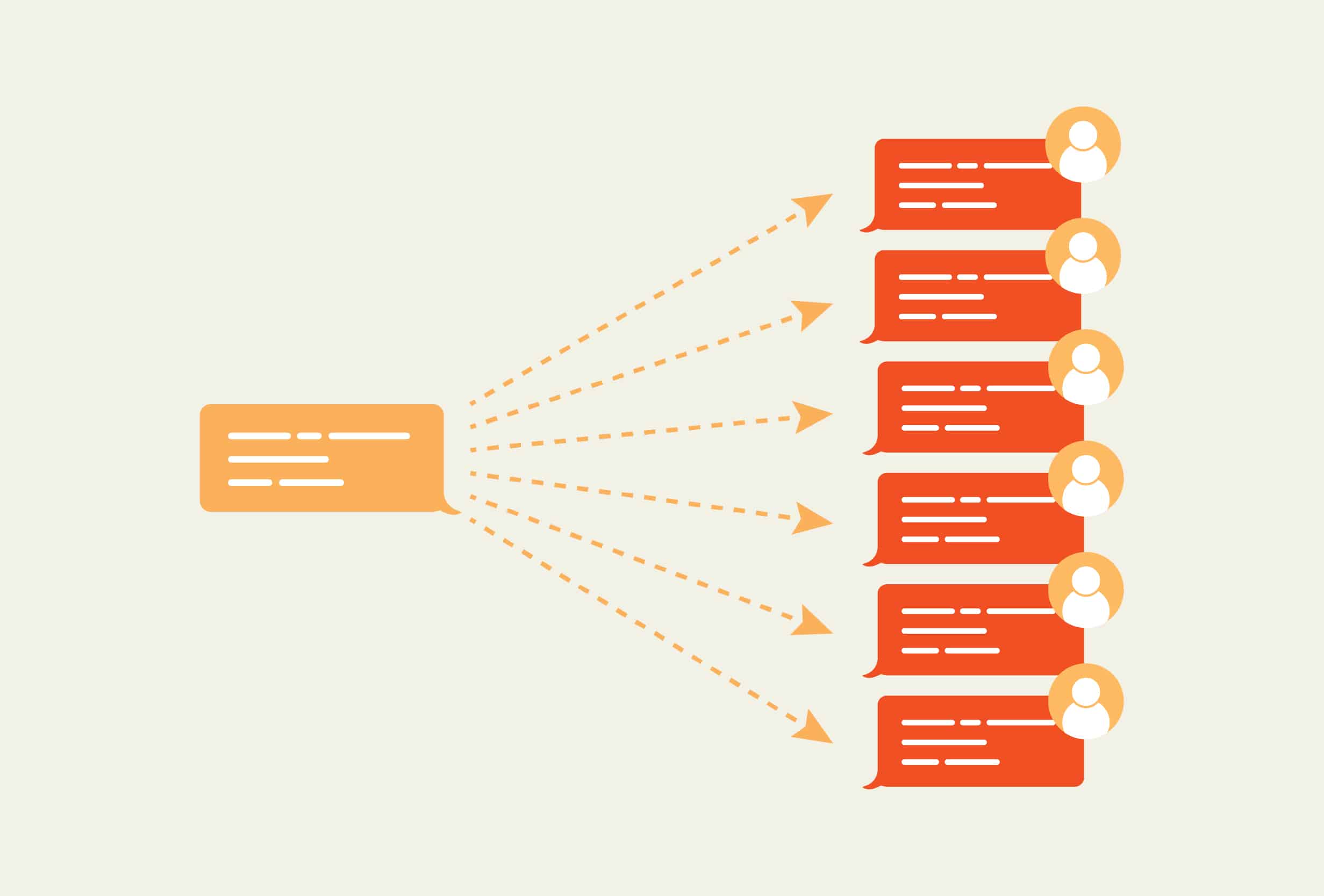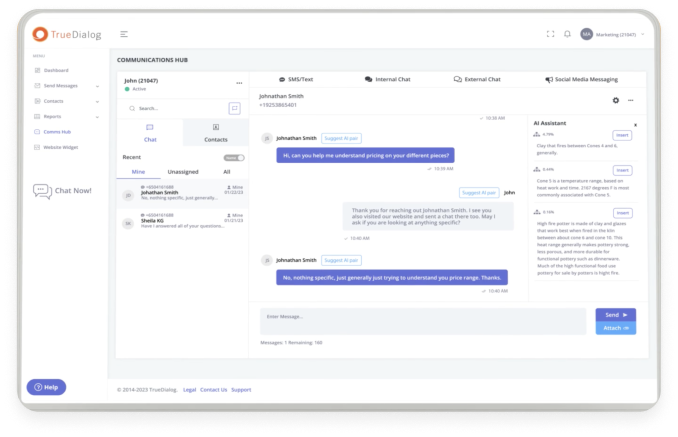A lot has changed since the first text message was transmitted a mere three decades ago. Since then, mobile phones have evolved from giant corded bricks with limited capabilities to slim touchscreen computers that practically run our entire lives.
However, while the processing power, functionality, and aesthetics of modern smartphones make 90s devices seem like ancient artifacts, some things haven’t changed. For example, Short Messaging Service (SMS) — the messaging technology used to send the first text — remains the most popular option for mobile phones. Although, according to some experts, that may soon change.
In 2017, cellular networks began slowly rolling out a new communication protocol called Rich Communication Services (RCS), and kicked off the great RCS vs. SMS debate. Although SMS is still the global standard, adoption of this new form of messaging is growing exponentially.
But what is the real difference between the two? What are the benefits and drawbacks of these two message technologies? And, most importantly, how could this impact your text marketing efforts?
In this guide, we’re breaking down everything you need to know.
What Is SMS?
SMS (Short Message Service) is the original messaging standard that has faithfully facilitated billions of text conversations for more than 30 years.
Nearly every mobile device in existence is SMS-compatible, which means you could use this protocol to reach practically any mobile user around the world — regardless of whether you have Wi-Fi. In fact, even if you use another messaging service (like iMessage), devices often default to SMS when other channels fail. (For iPhone users, this is when you see the “green bubble.”)
When you send a text using SMS, your phone pings the closest cell tower, and the tower transmits your message to the mobile carrier, which then routes your message to the recipient.
When you send an SMS as a business, that message goes through a Communication Platform as a Service (CPaaS), which then communicates with carriers (either directly or via third parties) to route your message to your recipients.
The speed and simplicity of this process depend on which bulk text messaging platform you use. For example, unlike most other solutions, TrueDialog cuts out the middleman to help reduce message failures and eliminate other complications that slow delivery.
What Is RCS?
Rich Communication Services is a more modern standard for mobile messaging that supports rich chat features (like images, GIFs, videos, and interactive experiences).
Developed by the Global System for Mobile Communications Association (GSMA) — the international trade association for mobile network operators — RCS functions similarly to iMessage or WhatsApp by using the internet to send and deliver texts instead of relying on a cellular network. While this standard is still relatively new in the U.S., it’s been widely adopted in Europe for several years.
When you send one of these messages, your phone communicates with an RCS server, which sends it to the recipient. If the recipient’s phone or mobile carrier doesn’t support RCS, the message will usually default back to a standard SMS.
To send mass RCS messages, you’ll need to use an RCS-enabled platform. Similar to the process for SMS, the platform you choose will connect with carriers directly or via aggregators to deliver your message (or fall back to an SMS when RCS isn’t supported).
Key Differences Between RCS and SMS
When you start comparing RCS vs. SMS, your first question is probably, “Which one is better?”
The answer is (annoyingly) that it depends on several factors — such as which devices your recipients use, whether or not they have reliable internet access, and what you need to convey in your messages.
To help you better understand, here are some of the key differences between these two popular messaging protocols:
Media and Interactivity
The primary difference between the two is that RCS supports rich media — like images, videos, audio, GIFs, and interactive media features — while SMS is limited to plain text. RCS also displays typing indicators so you know when someone is actively composing a response, and read receipts to show when someone has engaged with your message.
Security
Another key differentiator is that RCS offers better security than SMS. While RCS doesn’t necessarily ensure end-to-end encryption (since that depends on the provider), it encrypts messages while they’re in transit. SMS, however, does not encrypt messages — which can make it a less desirable choice for sharing sensitive information.
Delivery
When it comes to reliable delivery, SMS comes out on top. Because messages are transmitted through a cellular signal, you don’t need Wi-Fi or data to send or receive an SMS. On the other hand, RCS uses internet servers, which means that both the sender and recipient need a data connection for messages to be sent and delivered.
Compatibility and Reach
One of the biggest points of contention in the messaging type debate is compatibility. SMS is supported on virtually all mobile devices, regardless of manufacturer or carrier, which is why it remains the global standard. This, combined with the fact that SMS works without internet or mobile data, means it has superior reach compared to RCS.
Of course, this has changed over time, as people upgrade their devices. While not all Android devices support RCS, it’s available on most Android smartphones released since 2019.
Additionally, Apple also released RCS for Messenger as part of its iOS 18 update in 2024, which means this type of messaging is supported on any Apple device compatible with this update. The challenge is that iPhone users may have to toggle on RCS on their devices. People who haven’t done so (or don’t realize they need to) may not receive all RCS messages. However, once it is more universally adopted, it will likely become the default, and the need to turn it on will die off.
It’s also important to point out that while many major U.S. carriers support RCS, some smaller mobile carriers are slower to adopt this protocol. However, they may do so as demand continues to increase.
RCS vs SMS in Business Use
When it comes to business use cases, RCS and SMS each have their strengths and weaknesses. For example, RCS offers more modern features that can make a greater impact on your audience (like including brand verification and an organization’s logo in messages so users feel more comfortable engaging), but SMS ensures more reliable delivery. RCS can be more secure, but not if those messages automatically default to SMS when a carrier or device doesn’t support rich communications. In other words, there are circumstances when it makes more sense to leverage the new and improved messaging type, and there are other times when it’s best to stick with the universal standard.
Why SMS Still Works
The digital ecosystem has changed dramatically over the past couple of decades, yet SMS continues to deliver powerful results. Despite its plain, no-frills experience, organizations of all sizes still rely on SMS campaigns to reach their customers and drive engagement.
Since SMS has been around much longer and has remained the standard since the invention of texting, it will likely remain the default backup — even as RCS gains more ground. But aside from its age, there are a few other benefits that make SMS a solid choice for mass text purposes:
-
Unparalleled reach
A 2024 survey by Pew Research found that nearly all Americans (98%) own a cellphone — which means that 98% of Americans can receive an SMS message. It’s hard to imagine finding another digital channel with this level of reach. In fact, even the number of U.S. internet users with an email address (92% according to Statista) falls short. In other words, so long as people opt in to your messaging, there’s virtually no limit to how large you can grow your audience.
(And if you use an SMS platform like TrueDialog that specializes in serving enterprise-sized organizations, you can rest assured your messages will always be delivered — even if you’re sending millions of texts a day.)
-
Reliability
As mentioned, SMS is universally supported by nearly every mobile device and carrier worldwide. From the newest smartphones to the oldest operating flip phones and the most basic prepaid feature phones, every one of your contacts can receive an SMS — even if they don’t have a data or internet connection. This makes SMS an exceptional choice for sending time-sensitive communications — like, for example, a bank alerting a customer that their balance is low so they don’t accidentally overdraft, or a university warning students about a safety concern on campus.
-
Simplicity
While rich media can be engaging, sometimes all you need is a quick, concise message to get your point across. Plus, you don’t have to worry about critical elements of your message being stripped away (which can happen when a recipient can’t receive RCS). Since SMS is the default, it will always look exactly as expected and intended.
Where RCS Wins
Of course, while simplicity and reliability are significant advantages, there’s a reason RCS was invented. Today’s audiences are seeking more immersive, interactive, and visually engaging experiences — particularly younger audiences who grew up in mobile-first environments and have become accustomed to sleeker, more modern interfaces when engaging with brands. And that’s something RCS can help you deliver.
This next-generation messaging protocol allows you to create dynamic customer journeys directly within a contact’s default messaging app and deliver the rich, seamless experiences that consumers desire.
Here are a few of the ways RCS can support businesses looking for more modern messaging:
-
Enhanced flexibility
Rich Communication Services was specifically developed to offer more functionality than SMS, and the addition of rich media capabilities can help you create more flexible and easier-to-navigate user experiences.
For example, RCS supports preset responses or CTA buttons (such as “View Order”, “Sign Me up!” or “Get Directions”), allowing a recipient to simply tap a response instead of typing a message back. You can also configure multiple buttons for a single message. For example, a B2B software company might send a message about a new piece of content with options to “Download Now” or “Email it to Me,” or an invite to a webinar with options to “RSVP” or “Decline.”
Additionally, businesses can set buttons to open a location on a map, create a calendar event, pull up order tracking, set a reminder, or navigate to a specific URL, thereby removing friction from tasks like appointment confirmations and making an already simple experience even more convenient.
It also gives you the power to create and send “rich cards” (i.e, scrollable carousels of images that each display unique text and calls-to-action). This interactive feature is great for showcasing new products or delivering information in a way that’s compelling and easy to consume. For example, a financial services company might leverage an image carousel to help customers compare multiple credit cards, or a business might use this feature to highlight the advantages of joining its loyalty program.
Additionally, because messages are sent over a data network, the new messaging type enables you to send large files, like videos and PDFs, up to 100MB. This can be helpful for B2B tech companies that want to quickly share a product demo or updated contract terms with their client base.
-
Better branding opportunities
Rich media also makes it easier to customize their RCS messages using your logo and brand colors, which can make text campaigns feel more visually appealing, polished, and trustworthy. It delivers the look and feel of a fully branded chat experience, without requiring the recipient to download a separate app or navigate to your mobile website.
-
More generous character limit
SMS has a strict 160-character limit, which means longer messages are split into multiple segments. Depending on the length of your message and the number of recipients you’re aiming to reach, this can get pretty costly. On the other hand, RCS messages can go up to 3,072 characters. And while we advise against sending 3,000+ character missives to your contacts (unless you’re hoping for a hefty unsubscribe rate), sending via RCS eliminates the need to send multiple SMS segments.
How to Choose RCS or SMS
RCS offers numerous advantages for organizations that want to deliver a visually engaging 2-way SMS messaging experience. On the flipside, while SMS is less feature-rich, it does offer superior reliability and reach.
So, how do you decide whether to send an RCS vs. SMS message campaign? Here are three steps to help you determine which messaging protocol is the best fit:
Step one: Define your goal
Next, take a moment to determine the primary objective for this campaign. For example, a marketer at a software company might schedule a text message to boost attendance for an upcoming webinar. Meanwhile, a university might send 24-hour reminders about advising appointments to reduce the number of no-shows. You may also use texts to announce a new product, gather feedback, or share a limited-time offer. Whatever the case, ensure you have one clearly defined goal.
Step two: Identify your audience
An extremely important step in deciding whether to send an RCS or SMS message (or any type of marketing campaign, for that matter) is to consider your target audience or specific segment you intend to reach.
Ask yourself:
- What are their interests and expectations?
- What types of devices do they use?
- What types of content have they engaged with most in the past?
- Are they likely to have a data connection when they receive the message?
Step three: Evaluate the complexity of your campaign
How complex is your message? For example, are you sending a short one-way message (such as an alert or notification), or doing something more elaborate, like walking users through a new feature of your app?
Keep in mind that you can always adopt a hybrid messaging strategy, too. In this case, you can leverage the advantages of RCS to create a highly engaging experience for RCS-compatible devices, while ensuring that the message remains actionable and engaging even if it’s sent as an SMS.
Here are two examples using the steps above:
Example 1: Suppose you’re a marketer at a sports venue and you want to send a text to tell ticket holders about a pre-game special at the stadium pub. Your fans are a diverse bunch using a wide variety of devices, and you also know that Wi-Fi bandwidth can be unreliable when the stadium is at full capacity. So, in this case, sending the campaign via SMS makes the most sense.
Example 2: Imagine you’re a marketer at a B2B tech company and you want to send a text to announce the launch of a new product and drive people to a landing page to sign up for a demo. You know the majority of your audience has newer iPhone or Android devices, and will be receiving the message during the workday (when they have reliable Wi-Fi connectivity). You plan to send a message highlighting the most compelling product features to pique their interest. In this case, an RCS message is the better choice.
Why Choose TrueDialog
The RCS vs. SMS debate has grown with the increased adoption of the newer messaging protocol, but the good news is that you don’t have to settle for just one option. By choosing a platform that supports campaigns across SMS and RCS — as well as MMS, WhatsApp, Facebook Messenger, and WebChat — from one central solution, you can broaden your reach and deepen your engagement.
Interested in exploring seamless multi-channel communication? Request a demo

